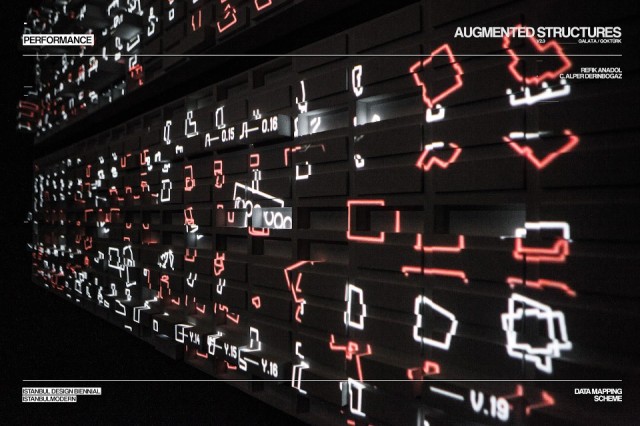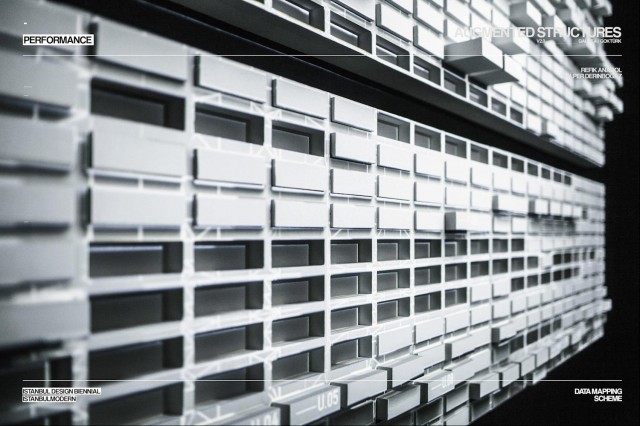Augmented Structures v2.0 / Istanbul Design Biennial / October 13th – December 12th, 2012 from Refik Anadol on Vimeo.
Our century is marked by a wash of data, flooding out of explosive urbanization. Humans and numbers, it seems, are now densely packed, dynamic, and essential. Yet with that same density, they threaten to become invisible.
The challenge of visualists: break the barrier to reveal that unseen world. Call it data mapping.
“Augmented Structures” is, first and foremost, rather lovely to look at. It’s a kind of architectural performance, in glitching, flickering contrasts of sound and light. Maybe the scale of transformation requires something aesthetic. Here’s what co-creator Refik Anadol has to say about it – thanks, Refik, for sending in your work.
‘Augmented Structures v2.0’ by Refik Anadol and Alper Derinbogaz is a distilled urban experience project which focuses on two dissimilar regions in istanbul and displays the inner characteristics of the texture of a city-center that has undergone a recent transformation within a suburban region consisting of gated communities. Presented at Istanbul Design Biennial within the ‘Musibet’ exhibition curated by local architect Emre Arolat, the work is based on soundscape and data mapping of two regions reveals the invisible information about their context and suggests an alternative way to understand the existence of urbanization through new media technologies.
By bringing disparate disciplines like sound, architecture and visual arts together, the development re-examines the world in aesthetic terms, in its capacity as an ‘interdisciplinary transformation’. ‘augmented structures series forces each discipline to alter its own ‘material’ state; transforming sound into mathematics, mathematics into architecture and architecture into a living structure, while presenting the viewer with a new media experience that is multi-levelled, produces sound, moves and breathes.’
The project in this case is augmented sculpture, beamed onto a structure. But I wonder how this same data might become part of the tapestry of architecture or urban experience. Perhaps that’s not where it belongs – maybe it’s best kept independent, a mirror in art. Whatever the context, it’s only natural that this substance of our age, data, would become artistic medium, rendered in terms as changing and fluid as it is.
More:
The team is diversified by sound designer Kerim Karaoglu and parametric designers Coşku Cinkılıç, Koray Bingöl. — at Istanbul Modern | Istanbul Museum of Modern Art.
Thanks to; IKSV, Emre Arolat, Nil Aynalı, Özlem Yalım Özkaraoğlu, Salon2, Antilop, Can Buyukberber, Başar Yurtçu.
From the same artist, Refik Anadol, here’s an intervention in urban space, with more fluid projections – and, again, a sonic element:
Augmented Structures v1.1 : Acoustic Formations / Istiklal Street from Refik Anadol on Vimeo.
Augmented Structures v1.1 : Acoustic Formations / Istiklal Street
Architecture and (Media) Design are art forms that exist independently from one another. Over the last few years they have been growing together. They are entering into symbiotic dependencies and stimulations. Against the background of the information technologies, architecture has gained a new reality. No longer are objects or processes the constituting elements of a building. Now they are described as technical networks of communicating nodes, which balance themselves in contrived patterns.
“Augmented Structures v1.1 : Acoustic Formations/Istiklal Street” is an augmented structure, an installation by Refik Anadol and Alper Derinboğaz which is created through the use of innovative parametric architecture and audiovisual techniques. The projects deals with a new mediated space: How to translate the logic of media into architecture? In this first experiment field recordings of Istiklal Street will be transformed in to parametric architectural structure. The recordings were made by Kerim Karaoglu who also used these recordings to create an electro-acoustical composition. The project seeks interactions between space, sound, visual and light. A similar connection between architecture and media has been experienced in Philips Pavilion of Le Courbusier in 1958.
Beyond being an artwork this installation is an urban experience. The scale of surface, 2000sqm, and the dominance of the location will definitely take place in collective memory of İstiklal Street visitors.
There will be an exhibition opening on 20th of September at 19:30 in relation to this façade installation which showcases experiments of architecture- sound – visual correlations of Refik Anadol and Alper Derinbogaz.
During the night visual performance will be projected on the structure which will be accompanied with a generatively designed contemporary aesthetic visuals consisting of input data from the recordings and their transformed versions synchronized to the movement of graphics re-shaping and transforming the structure on which they are projected. The structure in turn influences and transforms the projections as well.
For more information: augmentedstructures.com
Refik Anadol / New Media Artist
refikanadol.com
Alper derinbogaz / Architect
salon2.info
Sound Design: Kerim Karaoglu
VVVV Realtime Graphics: Sebastian Neitsch
Projection Infrastructure: Visio-vox

